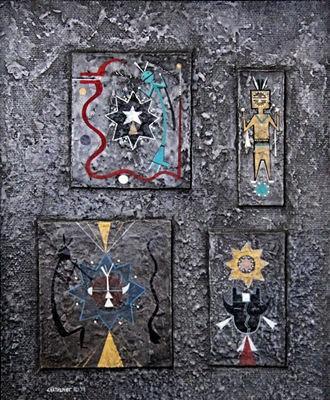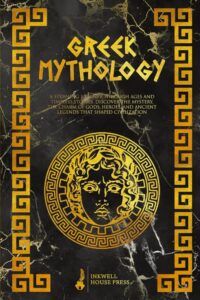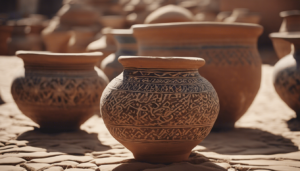Indigenous art serves as a vibrant expression of the profound connections between culture, nature, and spirituality. In contrast to Western art, which often emphasizes individualism, Indigenous art embodies communal values, emphasizing cultural expression and a deep relationship with the land and natural resources.
This piece examines the distinctive characteristics of Indigenous art, its representation of nature, and its role as a medium for spiritual beliefs and cultural preservation. Through examples such as dreamcatchers and totem poles, we explore the significance of these artistic traditions in promoting environmental stewardship and celebrating the narratives that connect Indigenous communities to their heritage, underscoring the importance of nature conservation and ecological practices.
What is Indigenous Art?
.jpg_00.jpeg)
Indigenous art constitutes a diverse range of artistic expressions—including textiles, ceramics, and sculptures—that are profoundly embedded in cultural identity, reflecting the shared beliefs, rituals, and value systems of Indigenous peoples.
This art frequently serves as a dynamic representation of traditional practices, demonstrating craftsmanship that forges connections between communities, their ancestors, and the natural environment.
Utilizing a variety of mediums, including painting, sculpture, weaving, and dance, Indigenous art articulates themes of community identity, spirituality, and reverence for the land, while safeguarding the rich cultural heritage and mythology that underpins Indigenous cultures.
How is Indigenous Art Different from Western Art?
Indigenous art exhibits considerable differences from Western art in terms of cultural significance, thematic representation, and the values it embodies, often incorporating symbols and motifs that reflect deep spiritual beliefs and ancestral knowledge. It frequently emphasizes spirituality and a profound connection with nature.
In contrast, Western art often prioritizes individualism and subjective expression. Indigenous art is fundamentally anchored in communal narratives, ancestral knowledge, and a deep respect for the environment.
This distinction is evident in the use of symbolism, motifs, and natural materials that convey messages reflective of Indigenous worldviews and the interconnectedness of all life.
What is the Role of Nature in Indigenous Art?
Nature holds a central position in Indigenous art, acting as both a source of inspiration and a provider of materials that embody a profound emotional connection with the environment, highlighting ecological awareness and the interconnectedness of all life.
Artists utilize the diverse landscapes, wildlife, and seasonal changes to produce artworks that represent their intricate relationship with ecosystems and the natural world, demonstrating themes of sustainability and harmony with the Earth. This connection is further demonstrated through the use of natural materials, highlighting a deep respect for life and a commitment to environmental stewardship—values that are fundamental to Indigenous cultures and artistic practices.
How is Nature Depicted in Indigenous Art?
Indigenous art represents nature through intricate patterns, vibrant colors, and symbolic motifs that encapsulate the essence of the land, wildlife, and ecological balance. Artists frequently depict landscapes in a manner that reflects their spiritual beliefs and deep connection with the environment, utilizing various art forms such as painting, weaving, and sculpture.
These artistic representations function as visual narratives that honor the relationship between Indigenous peoples and their surroundings.
For instance, the representation of local flora and fauna often carries profound meanings, where animals such as the eagle or the bear serve not merely as subjects but as sacred symbols embodying strength and wisdom, representing the intricate symbolic interactions within Indigenous cosmology. In landscape illustrations, rolling hills and flowing rivers may be presented not only as scenery but as living entities that convey stories of creation and harmony.
Aesthetic features such as earthy tones and flowing lines emulate the natural world, fostering an emotional connection to place and underscoring the significance of ecological stewardship. Through these elements, Indigenous art emerges as a rich tapestry that transcends mere decoration, inviting viewers to contemplate their own relationship with nature.
What is the Symbolism of Nature in Indigenous Art?
The symbolism of nature in Indigenous art represents a complex array of meanings, whereby elements such as animals, plants, and landscapes convey profound spiritual connections and cultural narratives. Each motif holds significant importance, frequently tied to storytelling, folklore, and the philosophical beliefs of Indigenous peoples, reflecting their worldview and their place within it.
These symbols serve not only as artistic representations but also as a vital conduit to ancestral knowledge and traditions.
For example, the bear is commonly portrayed as a symbol of strength and introspection, while the eagle signifies vision and a spiritual link to the creator. Such representations do not merely recount the stories of beings within the natural world; they also underscore the profound respect that Indigenous cultures possess for these elements.
The vibrant colors and intricate designs found in Indigenous art illustrate an understanding of the interconnectedness of all living things, emphasizing themes of sustainability, biodiversity, and the temporal cycles of nature. By incorporating these symbols into their artistic expressions, Indigenous peoples foster a dialogue with both their past and present, ensuring that their cultural heritage remains relevant and celebrated in contemporary society.
What is the Connection between Indigenous Art and Spirituality?
The relationship between Indigenous art and spirituality is deeply significant, with art serving as a medium for the expression of spiritual beliefs and practices that are fundamental to Indigenous cultures.
Various artistic forms, including ritual objects, totem poles, and ceremonial crafts, allow Indigenous artists to articulate their understanding of the cosmos, mythology, and the sacredness of nature.
This spiritual representation not only nurtures a sense of identity and continuity but also reflects the intricate relationship between art, belief systems, and community rituals, highlighting the significance of spiritual journeys and sacred geometry in Indigenous art.
How Does Indigenous Art Reflect Spirituality?
.jpg_01.jpeg)
Indigenous art serves as a profound reflection of spirituality, incorporating themes and philosophies that resonate with the beliefs of Indigenous peoples, often expressed through art forms like shamanism, vision quests, and ceremonial dance. This art often depicts sacred sites, ancestral connections, and the intricate relationship between nature and the spiritual realm.
The artistic practices are deeply rooted in a profound reverence for life and the universe, enabling artists to convey their spiritual narratives through visual expressions that honor their heritage and traditions, embracing elements of artivism and representational art.
Many artists employ natural materials, such as clay, wood, and feathers, which establish a direct connection to the environment, viewed as a living entity. For example, the creation of totem poles by Indigenous tribes in the Pacific Northwest functions not only as striking visual art but also as storytelling mediums that preserve and communicate sacred histories and the cultural significance of ancestral connections and sacred sites.
In a similar vein, the sand paintings crafted by Navajo medicine people serve a ritualistic purpose, embodying healing and spiritual focus. This illustrates how art operates as both a cultural practice and a sacred expression of interconnectedness with the cosmos.
What are the Spiritual Beliefs Portrayed in Indigenous Art?
Spiritual beliefs expressed in Indigenous art encompass a wide range of mythology and cosmological understandings that significantly shape the worldviews of Indigenous peoples. Artworks frequently depict creation narratives, ancestral figures, and symbols that illustrate the interconnectedness of all life, reflecting the traditional knowledge that has been transmitted through generations.
These representations offer valuable insights into the profound respect Indigenous cultures have for the land and the spiritual dimensions of nature, demonstrating the role of eco-spirituality and cosmic connections in Indigenous philosophy.
Through intricate designs and vibrant colors, these artworks serve not only as a means of artistic expression but also as a vehicle for preserving cultural identity and heritage. The narratives conveyed through these artistic forms invite viewers to engage with the deep relationships Indigenous communities maintain with their environment, exploring the cosmic connections and worldview perspectives integral to Indigenous art.
Elements such as the cycles of nature, animal spirits, and the significance of sacred sites are often illustrated, demonstrating how their spiritual beliefs are intertwined with their connection to the land, reflecting the deep philosophical and ecological awareness present in Indigenous worldview.
This artistic language functions as a bridge, facilitating a deeper understanding of Indigenous philosophies and highlighting the essential role these beliefs play in guiding their everyday lives, promoting art education and cultural expression as vital components of Indigenous identity politics.
What is the Significance of Indigenous Art in Preserving Culture and Traditions?
Indigenous art plays an essential role in the preservation of culture and traditions, acting as a medium for storytelling and a means of sustaining community identity.
Through diverse forms of artistic expression, Indigenous peoples communicate their histories, beliefs, and values, thereby facilitating the transmission of cultural knowledge across generations.
This preservation is critical for the identity of Indigenous communities, enabling them to address contemporary challenges while remaining firmly connected to their heritage and ensuring the continuity of cultural traditions and Indigenous rights.
How Does Indigenous Art Preserve Cultural Stories and Traditions?
Indigenous art plays a crucial role in preserving cultural stories and traditions by capturing narratives through various artistic practices that reflect the values, rituals, and experiences of Indigenous peoples, ensuring the legacy of community traditions and spiritual expression. These artworks often serve as visual representations of oral traditions, encapsulating historical events, folklore, and teachings that embody the wisdom and identity of the community, functioning as artistic narratives that preserve Indigenous languages and knowledge systems.
By integrating stories into their art, Indigenous artists ensure that cultural knowledge remains vibrant and accessible for future generations, fostering community engagement and the preservation of cultural heritage through artistic expression.
This dynamic interaction between storytelling and artistry resonates profoundly with members of these cultures while also inviting broader engagement. In galleries, community spaces, and during public events, artists intertwine their narratives with performances, visual arts, and traditional rituals, fostering dialogues that celebrate and honor ancestral connections.
The emphasis on community engagement reinforces the threads of cultural identity, as shared stories enhance collective memory and highlight the importance of cultural heritage.
By highlighting these narratives within their works, Indigenous art serves as both a refuge of heritage and a vital tool for advocacy. It illuminates the significance of cultural continuity, resilience, and the deep connection to Nature in the face of modern challenges.
What is the Importance of Passing Down Indigenous Art Techniques?
The transmission of Indigenous art techniques is crucial for sustaining cultural continuity and preserving the craftsmanship that embodies Indigenous heritage. These techniques, deeply rooted in ancestral knowledge and spiritual beliefs, enable younger generations to engage meaningfully with their cultural identity and maintain a connection to their ancestors.
Through mentorship and community collaboration, the sharing of artistic practices ensures that the distinctiveness of Indigenous art continues to thrive in an ever-evolving cultural landscape.
Artisans not only impart technical skills but also instill a sense of pride in cultural identity, thereby emphasizing the importance of traditional practices that resonate within contemporary art narratives. By fostering environments conducive to mentorship and community traditions, communities establish a foundation for nurturing creativity and innovation, thus reinforcing a shared legacy.
The interplay between heritage and modern techniques enhances artistry, reflecting both individual expression and collective experiences and values. This essential exchange promotes a deeper understanding of how ancestral knowledge can inspire contemporary interpretations, ensuring that culturally significant practices remain dynamic and relevant for future generations.
How Does Indigenous Art Contribute to Environmental Conservation?
Indigenous art plays a significant role in environmental conservation by embodying principles of sustainability and respect for the land, reflecting the profound ecological knowledge possessed by Indigenous peoples. This art often symbolizes the interdependence and harmony with the Earth and natural resources.
Through the artistic representation of natural elements, ecosystems, and wildlife, these artists raise awareness regarding environmental issues, biodiversity, and advocate for the protection of sacred spaces and resources.
This interdependence between art and nature underscores the importance of maintaining ecological balance, fostering a harmonious relationship with the environment, and preserving the biodiversity that is crucial for the sustainability of Earth.
What is the Relationship between Indigenous Art and Environmentalism?
.jpg_10.jpeg)
The relationship between Indigenous art and environmentalism is defined by a mutual commitment to the preservation of ecosystems and the promotion of sustainable practices. Indigenous artists frequently draw upon traditional knowledge to emphasize the significance of environmental stewardship and eco-spirituality, utilizing their art as a platform to advocate for conservation initiatives.
This synergy between artistic expression and environmentalism highlights the cultural importance of nature and the interconnectedness of all life within Indigenous communities.
These collaborative efforts not only reflect Indigenous identity but also serve as a powerful reminder of the interconnectedness of all life. By intertwining compelling narratives with urgent ecological issues, artists effectively convey the necessity of protecting natural habitats from threats such as climate change, industrialization, and loss of biodiversity.
This dynamic exchange fosters a rich dialogue that engages broader audiences, prompting recognition of the wisdom inherent in traditional practices. As these artists collaborate with environmental movements, they cultivate a deeper understanding of the delicate balance between humanity and the Earth, reminding society of the collective responsibility to nurture the planet for future generations and promote sustainable ecological practices.
How Does Indigenous Art Promote a Connection with Nature?
Indigenous art fosters a profound connection with nature by representing natural elements that embody the cultural identity and spiritual beliefs of Indigenous peoples. Through various artistic forms, these artists articulate their relationships with landscapes, wildlife, and ecosystems, cultivating a sense of respect and harmony with the natural world. This connection is essential for comprehending the cultural narratives that celebrate the interdependence of life and the environment, and the importance of biodiversity and natural landscapes.
For instance, dreamcatchers and totem poles convey stories that honor animals, plants, and celestial bodies, functioning as visual representations of the ecological knowledge and teachings passed down through generations. The utilization of traditional materials, such as clay, textiles, and wood, not only underscores sustainable practices but also reinforces the bond between the Creator and the land.
These artistic expressions encapsulate the emotional depth of Indigenous peoples’ experiences, reflecting their reverence for nature, which is intricately woven into their cultural identity and spiritual beliefs. In this manner, Indigenous art serves as a powerful medium for environmental narratives that advocate for ecological stewardship, cultural preservation, and the protection of sacred sites.
What are Some Examples of Indigenous Art that Reflect Relationships with Nature and Spirituality?
Notable examples of Indigenous art that exemplify relationships with nature and spirituality include:
- dreamcatchers
- totem poles
- sand paintings
- rock art
- beadwork
Each of these artistic forms encapsulates the essence of Indigenous beliefs and cultural narratives, frequently employing natural materials and traditional techniques that celebrate the interconnectedness of life, spirituality, and the environment. These forms include paintings, sculpture, dance, music, and oral traditions, which all serve to reinforce the collective identity and spiritual journeys of Indigenous peoples.
Through these diverse expressions, artists convey their profound respect for nature and its integral role in their spiritual and cultural identity.
1. Dreamcatchers
Dreamcatchers are traditional Native American artifacts that serve to protect individuals from negative energies while promoting positive dreams. These intricate weavings often utilize natural materials and complex patterns, reflecting the spiritual beliefs, cultural significance, and cosmic connections inherent in Indigenous art.
Originating from various Indigenous tribes, particularly the Ojibwa (Chippewa), the dreamcatcher was historically crafted from willow hoops and embellished with feathers and beads, with each component carrying specific meanings and symbolism. The circular shape symbolizes the cycle of life and the interconnectedness of existence, while the web-like design functions as a filter, permitting good dreams to pass through while capturing negative ones.
In contemporary Indigenous culture, dreamcatchers have transcended their role as mere decorative items; they now embody a rich tapestry of spirituality and traditional practices. They serve as a reminder of heritage and highlight the importance of protecting one’s dreams from negativity and the spiritual expression of Indigenous peoples.
2. Totem Poles
Totem poles are monumental sculptures carved from trees, frequently representing animals, ancestors, and spirits that embody the cultural heritage and identity of Indigenous groups, particularly among the tribes of the Northwest Coast. These art forms are significant symbols of community traditions and worldview perspectives.
These artistic creations serve as storytelling mechanisms, articulating the values, beliefs, and histories of the community through an intricate visual narrative that includes representational art and mythological elements.
Each pole functions as a living archive, symbolizing clan lineages, significant events, and moral lessons that resonate profoundly within the collective memory of the community. The totems often incorporate symbols, patterns, and colors that reflect the identity and philosophy of the people.
The artistry involved in the creation of these poles is not solely for aesthetic appreciation; it encompasses deep spiritual significance and reflects a profound respect for nature and the interconnectedness of all living beings. This is a form of eco-spirituality and artivism, promoting environmental stewardship and cultural identity.
Communities gather in ceremonies around these structures, promoting a sense of belonging and pride while ensuring that their unique traditions and stories are transmitted across generations. This process reinforces their cultural identity, spiritual journeys, and connection to sacred sites in the face of a rapidly evolving world.
3. Sand Paintings
Sand paintings represent a distinctive form of Indigenous art, particularly prominent within Navajo cultures, utilized in rituals and ceremonies. These intricate designs are created on the ground as part of healing practices and carry profound spiritual significance, often reflecting cosmological beliefs, cultural expression, and the artist’s connection to the natural world.
Each sand painting serves not only as an aesthetic expression but also as an essential element in spiritual healing rituals. The creation process involves meticulously applying colored sands and natural materials, often arranged in elaborate patterns that symbolize various aspects of life, health, and the universe. These patterns and colors are integral to the cultural significance and spiritual beliefs of the artist.
The completed artwork is typically employed within a ceremonial context, during which participants engage in prayers and songs to amplify its spiritual potency. Upon the conclusion of the ritual, the painting is generally destroyed, symbolizing the impermanence of life and the release of healing energies back into the earth. This act highlights the interconnectedness of life cycles and the temporal cycles of existence.
This act serves as a poignant reminder of the cyclical nature of existence.
4. Rock Art
.jpg_11.jpeg)
Rock art, encompassing petroglyphs and pictographs, constitutes some of the earliest forms of Indigenous artistic expression, serving as a historical record of cultural beliefs, practices, and interactions with the environment. These artworks frequently illustrate animals, human figures, and symbolic motifs that convey the spiritual and cultural narratives of Indigenous peoples. They are examples of representational art and visual storytelling that connect past and present experiences.
The intricate designs present in these ancient art forms reveal profound connections to the natural world, standing as a testament to the knowledge and traditions that have been transmitted through generations. Each line and color is imbued with meaning, often reflecting the cosmology and social structures of the communities that produced them. These visual arts serve as artifacts of ancestral knowledge, representing the worldview and spiritual beliefs that resonate with the rhythms of Earth and its biodiversity.
The significance of rock art transcends mere aesthetics; it embodies the spiritual expressions, rituals, and communal identities intrinsic to ancient cultures. This continuity of artistic tradition not only honors past practices but also reinforces the enduring legacy and resilience of Indigenous identities in contemporary society. Such expressions are deeply connected to sacred sites and natural resources, highlighting the ecological awareness and commitment to environmental stewardship within these communities.
5. Beadwork and Quillwork: Threads of Tradition and Culture
Beadwork and quillwork are intricate art forms that exemplify the exceptional craftsmanship of Indigenous artisans. These techniques are frequently employed to create clothing, accessories, and ceremonial items, reflecting traditional practices and the cultural identity of Indigenous peoples. The patterns and colors utilized in these works carry specific meanings and narratives, acting as symbols of cultural heritage and spiritual journeys.
Through meticulous attention to detail, these artisans not only demonstrate their skills but also preserve their heritage, infusing each piece with stories that connect past and present generations. Beadwork often employs vibrant colors arranged in specific patterns that symbolize tribal affiliation or individual narratives, while quillwork, characterized by its delicate use of porcupine quills, highlights both the beauty of nature and the resourcefulness of its creators. These forms of artistic expression are integral to the storytelling and representation of Indigenous knowledge systems and mythology.
As contemporary Indigenous art continues to evolve, these traditional techniques are increasingly embraced within modern contexts, facilitating dynamic cultural expression that honors ancestral customs while also establishing a presence in current artistic discussions. This continuity is essential for ensuring that Indigenous identities remain vibrant and relevant in an ever-changing world. The integration of eco-spirituality, nature conservation, and artivism within this evolution fosters a deeper appreciation and respect for the interconnectedness of all life forms, promoting harmony and sustainability.
Frequently Asked Questions
What is Indigenous Art and Cultural Heritage?
Indigenous art refers to the creative works of Indigenous peoples, which encompasses a wide range of traditional forms such as painting, sculpture, weaving, and storytelling. These art forms are not only aesthetic expressions but also carry cultural significance and convey Indigenous rights, identity politics, and community engagement.
How does Indigenous Art Reflect Relationships with Nature and Environment?
Indigenous art often depicts elements of the natural world such as animals, plants, and landscapes, highlighting the deep connection and respect Indigenous peoples have for nature. Through visual storytelling and symbolic interactions, these art forms express a profound ecological awareness and commitment to nature connections.
What Role Does Spirituality and Rituals Play in Indigenous Art?
Spirituality is an integral part of Indigenous art, as it reflects the spiritual beliefs and practices of Indigenous communities, including their close relationship with the natural world. Ritual practices, ceremonies, and shamanism are often depicted, illustrating the cosmic connections and spiritual journeys of Indigenous peoples.
How is Indigenous Art Used to Pass Down Cultural Knowledge and Ancestral Wisdom?
Through symbols, patterns, and stories depicted in Indigenous art, cultural knowledge and traditions are preserved and passed down from one generation to the next. This visual narrative serves as a powerful means of art education, ensuring the preservation of Indigenous languages, myths, and oral traditions.
What is the Significance of Traditional Techniques and Natural Resources in Indigenous Art?
The use of traditional techniques and materials in Indigenous art is a way to honor and maintain cultural practices and connections to the land. This practice underscores the value of sustainability and the responsible use of natural resources, ensuring the continuation of cultural expressions and ecological practices.
How Does Indigenous Art Promote Environmental Conservation and Stewardship?
Indigenous art often portrays the interconnectedness between humans and nature, promoting the importance of caring for the environment and preserving it for future generations. This art and ecology relationship advocates for environmental stewardship and the safeguarding of sacred landscapes, reflecting an eco-spirituality that is vital for planetary health.

My name is Bruno, I have been a writer for 5 years and I work with website creation. My goal is to provide true information to readers. In fact, on this site I write about cultures and traditions, which I have been passionate about since childhood.




